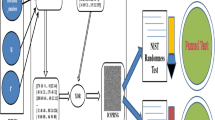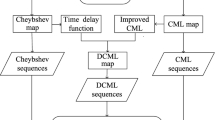Abstract
Pseudo-random number generator (PRNG) has been widely used in digital image encryption and secure communication. This paper reports a novel PRNG based on a generalized Sprott-A system that is conservative. To validate whether the system can produce high quality chaotic signals, we numerically investigate its conservative chaotic dynamics and the complexity based on the approximate entropy algorithm. In this PRNG, we first select an initial value as a key to generate conservative chaotic sequence, then a scrambling operation is introduced into the process to enhance the complexity of the sequence, which is quantified by the binary quantization method. The national institute of standards and technology statistical test suite is used to test the randomness of the scrambled sequence, and we also analyze its correlation, keyspace, key sensitivity, linear complexity, information entropy and histogram. The numerical results show that the binary random sequence produced by the PRNG algorithm has the advantages of the large keyspace, high sensitivity, and good randomness. Moreover, an improved finite precision period calculation (FPPC) algorithm is proposed to calculate the repetition rate of the sequence and further discuss the relationship between the repetition rate and fixed-point accuracy; the proposed FPPC algorithm can be used to set the fixed-point notation for the proposed PRNG and avoid the degradation of the chaotic system due to the data precision.











Similar content being viewed by others
References
Rotenberg, A.: A new pseudo-random number generator. J. ACM JACM 7(1), 75–77 (1960)
Tausworthe, R.C.: Random numbers generated by linear recurrence modulo two. Math. Comput. 19(90), 201–209 (1965)
Wikramaratna, R.S.: Theoretical and empirical convergence results for additive congruential random number generators. J. Comput. Appl. Math. 233(9), 2302–2311 (2010)
Marsaglia, G., et al.: Evaluating Kolmogorov’s distribution. J. Stat. Softw. 8(14), 1–6 (2003)
Widynski, B.: Squares: a fast counter-based RNG (2020). arXiv preprint arXiv:2004.06278
Murillo-Escobar, M.A., Cruz-Hernández, C., Cardoza-Avendaño, L., Méndez-Ramírez, R.: A novel pseudorandom number generator based on pseudorandomly enhanced logistic map. Nonlinear Dyn. 87(1), 407–425 (2017)
Tisa, S., Villa, F., Giudice, A., Simmerle, G., Zappa, F.: High-speed quantum random number generation using CMOS photon counting detectors. IEEE J. Sel. Top. Quantum Electron. 21(3), 23–29 (2014)
Elmanfaloty, R.A., Abou-Bakr, E.: Random property enhancement of a 1D chaotic PRNG with finite precision implementation. Chaos Solitons Fract. 118, 134–144 (2019)
Wang, X., Qin, X.: A new pseudo-random number generator based on CML and chaotic iteration. Nonlinear Dyn. 70(2), 1589–1592 (2012)
Hua, Z., Zhou, Y., Pun, C.M., Chen, C.L.P.: 2D Sine logistic modulation map for image encryption. Inf. Sci. 297, 80–94 (2015)
Hemdan, A.M., Faragallah, O.S., Elshakankiry, O., Elmhalaway, A.: A fast hybrid image cryptosystem based on random generator and modified logistic map. Multimedia Tools Appl. 78(12), 16177–16193 (2019)
Meranza-Castillón, M.O., Murillo-Escobar, M.A., López-Gutiérrez, R.M., Cruz-Hernández, C.: Pseudorandom number generator based on enhanced Hénon map and its implementation. AEU Int. J. Electron. Commun. 107, 239–251 (2019)
Dastgheib, M.A., Farhang, M.: A digital pseudo-random number generator based on sawtooth chaotic map with a guaranteed enhanced period. Nonlinear Dyn. 89(4), 2957–2966 (2017)
Liu, L., Miao, S., Cheng, M., Gao, X.: A pseudorandom bit generator based on new multi-delayed Chebyshev map. Inf. Process. Lett. 116(11), 674–681 (2016)
Sahari, M.L., Boukemara, I.: A pseudo-random numbers generator based on a novel 3D chaotic map with an application to color image encryption. Nonlinear Dyn. 94(1), 723–744 (2018)
Mansingka, A.S., Zidan, M.A., Barakat, M.L., Radwan, A.G., Salama, K.N.: Fully digital jerk-based chaotic oscillators for high throughput pseudo-random number generators up to 8.77 Gbits/s. Microelectron. J. 44(9), 744–752 (2013)
Zhao, Y., Gao, C., Liu, J., Dong, S.: A self-perturbed pseudo-random sequence generator based on hyperchaos. Chaos Solitons Fract. X 4, 100023 (2019)
Vidhya, R., Brindha, M., Gounden, N.A.: A secure image encryption algorithm based on a parametric switching chaotic system. Chin. J. Phys. 62, 26–42 (2019)
Farah, M.A.B., Guesmi, R., Kachouri, A., Samet, M.: A novel chaos based optical image encryption using fractional Fourier transform and DNA sequence operation. Opt. Laser Technol. 121, 105777 (2020)
Tsafack, N., Kengne, J., Abd-El-Atty, B., Iliyasu, A.M., Hirota, K., Abd-El-Latif, A.A.: Design and implementation of a simple dynamical 4-D chaotic circuit with applications in image encryption. Inf. Sci. 515, 191–217 (2020)
Zhang, Y., Wang, X.: A symmetric image encryption algorithm based on mixed linear–nonlinear coupled map lattice. Inf. Sci. 273, 329–351 (2014)
Wang, X., Feng, L., Zhao, H.: Fast image encryption algorithm based on parallel computing system. Inf. Sci. 486, 340–358 (2019)
Wang, X., Gao, S.: Image encryption algorithm based on the matrix semi-tensor product with a compound secret key produced by a Boolean network. Inf. Sci. 539, 195–214 (2020)
Zhang, Y., Wang, X.: A new image encryption algorithm based on non-adjacent coupled map lattices. Appl. Soft Comput. 26, 10–20 (2015)
Wang, X., Wang, Y., Wang, S., Zhang, Y., Wu, X.: A novel pseudo-random coupled LP spatiotemporal chaos and its application in image encryption. Chin. Phys. B 27(11), 110502 (2018)
Wang, S., Wang, C., Xu, C.: An image encryption algorithm based on a hidden attractor chaos system and the Knuth–Durstenfeld algorithm. Opt. Lasers Eng. 128, 105995 (2020)
Wang, X., Gao, S.: Image encryption algorithm for synchronously updating Boolean networks based on matrix semi-tensor product theory. Inf. Sci. 507, 16–36 (2020)
Li, Q., Wang, X., Wang, X., Ma, B., Wang, C., Shi, Y.: An encrypted coverless information hiding method based on generative models. Inf. Sci. 553, 19–30 (2021)
Zhang, Q.H., Zhang, H., Li, Z.H.: One-way hash function construction based on conservative chaotic systems. In: 2009 Fifth International Conference on Information Assurance and Security, vol. 2 pp. 402–405. IEEE (2009)
Hong, Z., Xieting, L.: Generating chaotic secure sequences with desired statistical properties and high security. Int. J. Bifurc. Chaos 7(01), 205–213 (1997)
Li, P., Li, Z., Fettinger, S., Mao, Y., Halang, W.A.: Application of chaos-based pseudo-random-bit generators in internet-based online payments. In: E-Service Intelligence, pp. 667–685. Springer (2007).
Nepomuceno, E.G., Junior, H.M.R., Martins, S.A.M., Perc, M., Slavinec, M.: Interval computing periodic orbits of maps using a piecewise approach. Appl. Math. Comput. 336, 67–75 (2018)
Nepomuceno, E.G., Mendes, E.M.A.M.: On the analysis of pseudo-orbits of continuous chaotic nonlinear systems simulated using discretization schemes in a digital computer. Chaos Solitons Fract. 95, 21–32 (2017)
Alvarez, G., Li, S.: Some basic cryptographic requirements for chaos-based cryptosystems. Int. J. Bifurc. Chaos 16(08), 2129–2151 (2006)
Flores-Vergara, A., García-Guerrero, E.E., Inzunza-González, E., López-Bonilla, O.R., Rodríguez-Orozco, E., Cárdenas-Valdez, J.R., Tlelo-Cuautle, E.: Implementing a chaotic cryptosystem in a 64-bit embedded system by using multiple-precision arithmetic. Nonlinear Dyn. 96(1), 497–516 (2019)
Tong, X., Cui, M.: Image encryption scheme based on 3D baker with dynamical compound chaotic sequence cipher generator. Signal Process. 89(4), 480 (2009)
Cang, S., Li, Y., Kang, Z., Wang, Z.: Generating multicluster conservative chaotic flows from a generalized Sprott-A system. Chaos Solitons Fract. 133, 109651 (2020)
Bassham, L.E., III., Rukhin, A.L., Soto, J., Nechvatal, J.R., Smid, M.E., Barker, E.B., Leigh, S.D., Levenson, M., Vangel, M., Banks, D.L., et al.: Sp 800–22 rev. 1a. A Statistical Test Suite for Random and Pseudorandom Number Generators for Cryptographic Applications. National Institute of Standards & Technology, Gaithersburg (2010)
Cang, S., Wu, A., Wang, Z., Chen, Z.: Distinguishing Lorenz and Chen systems based upon Hamiltonian energy theory. Int. J. Bifurc. Chaos 27(02), 1750024 (2017)
Kolmogorov, A.N.: Three approaches to the definition of the concept “quantity of information’’. Probl. Peredachi Inf. 1(1), 3–11 (1965)
Shannon, C.E.: A mathematical theory of communication. ACM SIGMOBILE Mob. Comput. Commun. Rev. 5(1), 3–55 (2001)
Pincus, S.M.: Approximate entropy as a measure of system complexity. Proc. Natl. Acad. Sci. 88(6), 2297–2301 (1991)
Su, Z., Lian, S., Zhang, G., Jiang, J.: Chaos-based video encryption algorithms. In: Chaos-Based Cryptography, pp. 205–226. Springer (2011)
Singh, S., Mandoria, H.L.: A review on image encryption technique and to extract feature fromimage. Int. J. Comput. Appl. 163, 1 (2017)
Francois, M., Grosges, T., Barchiesi, D., Erra, R.: A new pseudo-random number generator based on two chaotic maps. Informatica 24(2), 181–197 (2013)
Van Tilborg, H.C.A., Jajodia, S.: Encyclopedia of Cryptography and Security. Springer, Berlin (2014)
Massey, J.: Shift-register synthesis and BCH decoding. IEEE Trans. Inf. Theory 15(1), 122–127 (1969)
Persohn, K.J., Povinelli, R.J.: Analyzing logistic map pseudorandom number generators for periodicity induced by finite precision floating-point representation. Chaos Solitons Fract. 45(3), 238–245 (2012)
Acknowledgements
This work is partly supported by the National Natural Science Foundation of China (Grant No. 61873186), South African National Research Foundation (Grant Nos. 112142 and 112108), South African National Research Foundation Incentive Grant (No. 114911), and South African Eskom Tertiary Education Support Programme.
Author information
Authors and Affiliations
Corresponding author
Ethics declarations
Conflicts of interest
The authors declare that they have no conflicts of interest.
Additional information
Publisher's Note
Springer Nature remains neutral with regard to jurisdictional claims in published maps and institutional affiliations.
Rights and permissions
About this article
Cite this article
Cang, S., Kang, Z. & Wang, Z. Pseudo-random number generator based on a generalized conservative Sprott-A system. Nonlinear Dyn 104, 827–844 (2021). https://doi.org/10.1007/s11071-021-06310-9
Received:
Accepted:
Published:
Issue Date:
DOI: https://doi.org/10.1007/s11071-021-06310-9




